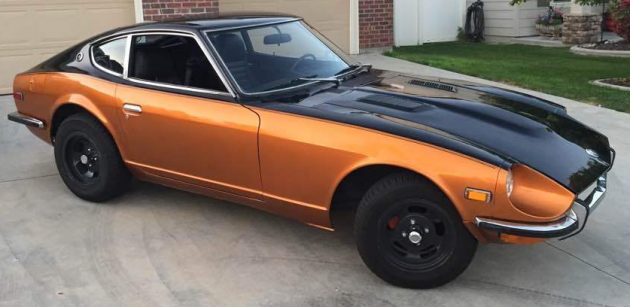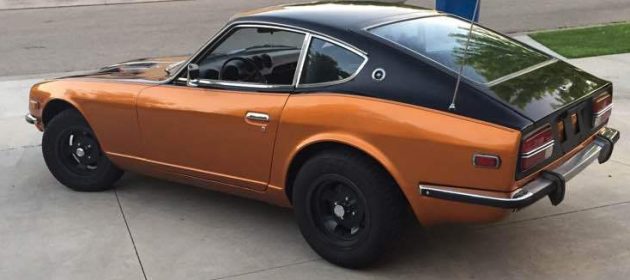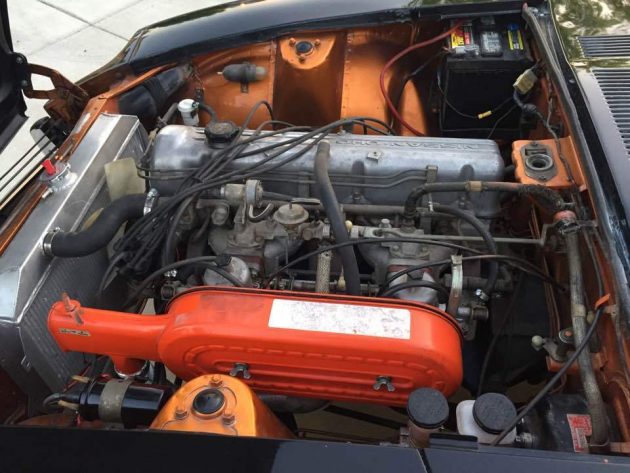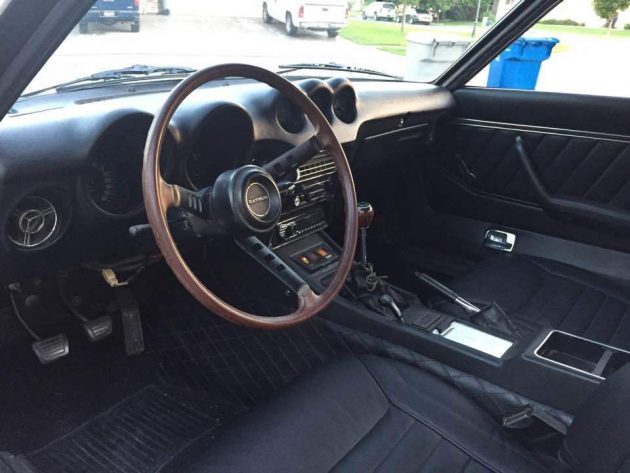Though I am a dyed-in-the-wool American classic car guy (specifically muscle cars), for the past few years I have also developed a soft spot for imports, especially from Japan from the 1960s up to the early to mid-1990s (typically stock or lightly modified). My friend from college, Brett, is a huge fan of Japanese cars, especially from the JDM market. So when he requested I write an article on “an EG civic hatch, Nissan S13 or 240X or one of the old Datsun Zs”, I happily obliged. One of my favorite Japanese cars is the Datsun 240Z; Roadkill built up a 1971 240Z (nicknamed the Rotsun for its substantial rust) initially with a 4.3L GM V6 and 5-speed from an S10, and more recently they swapped in a 302 and T-5 from a Fox-body Mustang GT convertible, turbocharging both motors with a Powerstroke turbo from a diesel Ford pickup truck. Additionally, I’ve always dug the BRE-liveried 240Zs and the ultra-rare and valuable Fairlady Z 432. This particular car is a 1972 model, and features an unusual but very cool two-tone paint scheme. Find it here on eBay in Nampa, Idaho, with an asking price of $11,000 OBO.
Introduced initially in October 1969 as a 1970 model, the 240Z was brought onto the market to compete not only against Toyota’s 2000GT, but also against sports car companies from England such as Jaguar, Triumph, and the two-years removed Austin-Healey 3000. Designed by Albrecht Goertz (who also designed the BMW 507) and a team led by Yoshihiko Matsuo, the head of Nissan’s Sports Car Styling Studio at the time, the 240Z took many of its styling cues from the Jaguar E-Type, yet utilized more muscular lines than the E-Type and cost the same price, in the United States, as a Triumph GT6. Powered by a 2.4L L24 straight-six, the 240Z could easily reach 125 miles per hour and featured a gruff growl from its L24 that was “pure machismo” according to “The Ultimate Illustrated Encyclopedia to Classic Cars”. Factor in a wonderful manual transmission (four speed for US Zs, five speed for non-US Zs) and superb handling thanks to its all-independent suspension, the 240Z drove and handled like a dream, drawing comparisons to the Austin-Healey and even, to an extent, the Jaguar E-Type, all while costing a third of the E-Type’s price. This 1972 model is a Series II car and lacks the hatch vents that the on Series 1 cars had. Originally painted 918 orange, the car is currently painted a two-tone black and burnt-sunset orange, which I’ve never seen on a 240Z, but looks insanely cool. The seller does state that “the paint on the car has some blemishes”, which should be touched up. He also mentions that “there is a small amount of rust present in the front driver side wheel well”, so that should be addressed as well. The seller also describes “all original glass, including the windshield”, as well as a hood swapped from a 280Z . The car does feature 14 inch black slotted mag wheels with brand-new Goodyear tires, but I would swap in a set of 15 or 16-inch Watanabe wheels in black or perhaps, if a set can be located, a set of Z432 magnesium wheels to complement the two-tone paint scheme. I would also remove the driver-side mirror and source a set of JDM-style fender-mounted mirrors, source some clear headlight covers, and remove the rear bumper guards for a clean, uninterrupted look.
The car does include its original engine, but it’s currently not installed due to low compression in two cylinders. Instead it has another L24 with a “new radiator, heater core, oil pump fuel pump, and filters/fluids”, but the owner does mention that the engine “does burn a small amount of oil and has a small leak from the rear main seal”, which should be addressed. Otherwise, the owner stresses that the car “starts, stops, and drives as it should”. I would swap out the aluminum radiator, rebuild the original engine, and address the issues with the current engine, while maybe making a few modifications to the L24 currently installed in the process. A little detailing to the engine and engine bay would not hurt either.
Arguably the nicest part of the car, the interior has recently been redone, with new carpet, new seat upholstery, a new half-dash cap, and a new aftermarket radio. The seller also swapped in door cards in the door panels from a 260Z, but since the door cards have different placement for the door lock tabs (compared to the stock 240Z ones), the door locks do not currently work. On the plus side, the original headliner is still in the car and is in “excellent condition”, according to the seller. I would swap the aftermarket radio for either a factory one or an era-correct aftermarket radio and source the correct 240Z door cards. This would be a perfect car to fix up weeknights and on the weekends, and once everything is sorted out mechanically and cosmetically this would be perfect to take to a local cars and coffee show. So I pose this question to you, viewers: what would you do with it?






In 1976, I purchased a low mileage 1972 Datsun 240Z from a local Datsun dealer. I loved the acceleration and the way it cornered. After just a few months, it developed a slight shimmy. The floorboards on both sides rotted out along with both frame rails. What a piece of junk.
Sorry to hear that Stu they were great cars except for the rust. My 72 purchased in 76 had body filler over duct tape with nice new red paint on top. That started falling off a few months later. I stripped it down, rebult the door Jamb’s and had Maco do the rear fenders. I primed the car and sent it back to Maco for a $150.00 paint job. After 3 years of a long distance daily driver, someone offered me more money than I thought the 135.000 mile car was worth. I wanted a black with gold trim paint, but the car had too many flaws.
Paint it. That’s gross.
Very nice writeup Mitchell, with lots of detail. I have owned some early 240Zs and am restoring an early 1st year car now. A few comments…
– Goertz was often credited with designing the Z car but he has said that although he didn’t design the Z car, he showed the Datsun designers how to do it.
– This is a striking car. Excellent early (Series 1, especially early first year cars) 240Zs are entering the collectible category. To bring big money ($35K to $60K) they need to be either completely original and near-perfect, or perfectly restored to the original build, including the original paint color.
– This car is a later car and has been given a custom paint job. I think the seller will be lucky to sell it at the $11K asking. It’s more of a $5 to 8K car, depending on whether someone who likes the exact paint treatment on the car comes along.
– It has a dash cap, has over 100K miles, and burns a little oil, which will also hold the price back.
– As Stu said, these cars can rust, and this one is in Idaho. That will trigger rust alerts in serious buyers, who will want to see whether there is much rust. The floors have patches, which is OK, but will still hold the value back. Also, as Stu said, the frame rails will need to be closely inspected since they can rust also.
– All that said, if it checks out it would still be a good way to spend modest money on a vintage car. And Z cars are on a rising value trajectory, so the buyer will probably not lose money when it sells down the road.
^^Agree
The question is not “is it rusty?” but “how MUCH rust is there?” This guy is asking all the money right now and more for a car with so many needs… mechanical, body, interior (why not get the right door cards in the first place?) $5-8K would be pushing it I think.
Outstanding write up! I really like these Z cars. They were miles ahead of what the British were turning out in that price range. Datsun really did their homework on these.
Gone already. Damn.
The wheels that are on it would look nice painted in the same burnt orange as the body.
Why would you paint a period set of aluminum slot dish mags black? Just have them mirror polished if they are oxidized……..
https://m.youtube.com/watch?v=6FNDvLPWxoM check this video if you want a laugh check out the numbers the 302 with the Powerstroke Diesel Turbo actually puts down! 620lb/ft of Torque & a plus of roughly 270hp over the stock non-turbo run! Crazy numbers for not a big initial outlay! Well worth considering if you want cheap power that can be reliable if you don’t turn the boost up too high!